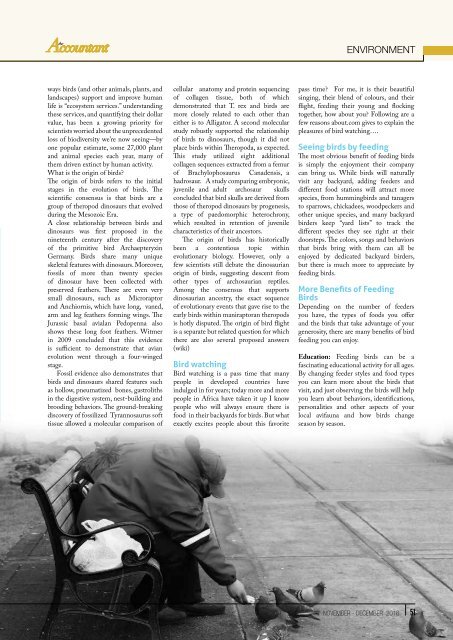The Accountant Nov-Dec 2016
Create successful ePaper yourself
Turn your PDF publications into a flip-book with our unique Google optimized e-Paper software.
ENVIRONMENT<br />
ways birds (and other animals, plants, and<br />
landscapes) support and improve human<br />
life is “ecosystem services.” understanding<br />
these services, and quantifying their dollar<br />
value, has been a growing priority for<br />
scientists worried about the unprecedented<br />
loss of biodiversity we’re now seeing—by<br />
one popular estimate, some 27,000 plant<br />
and animal species each year, many of<br />
them driven extinct by human activity.<br />
What is the origin of birds?<br />
<strong>The</strong> origin of birds refers to the initial<br />
stages in the evolution of birds. <strong>The</strong><br />
scientific consensus is that birds are a<br />
group of theropod dinosaurs that evolved<br />
during the Mesozoic Era.<br />
A close relationship between birds and<br />
dinosaurs was first proposed in the<br />
nineteenth century after the discovery<br />
of the primitive bird Archaepteryxin<br />
Germany. Birds share many unique<br />
skeletal features with dinosaurs. Moreover,<br />
fossils of more than twenty species<br />
of dinosaur have been collected with<br />
preserved feathers. <strong>The</strong>re are even very<br />
small dinosaurs, such as Microraptor<br />
and Anchiornis, which have long, vaned,<br />
arm and leg feathers forming wings. <strong>The</strong><br />
Jurassic basal avialan Pedopenna also<br />
shows these long foot feathers. Witmer<br />
in 2009 concluded that this evidence<br />
is sufficient to demonstrate that avian<br />
evolution went through a four-winged<br />
stage.<br />
Fossil evidence also demonstrates that<br />
birds and dinosaurs shared features such<br />
as hollow, pneumatized bones, gastroliths<br />
in the digestive system, nest-building and<br />
brooding behaviors. <strong>The</strong> ground-breaking<br />
discovery of fossilized Tyrannosaurus soft<br />
tissue allowed a molecular comparison of<br />
cellular anatomy and protein sequencing<br />
of collagen tissue, both of which<br />
demonstrated that T. rex and birds are<br />
more closely related to each other than<br />
either is to Alligator. A second molecular<br />
study robustly supported the relationship<br />
of birds to dinosaurs, though it did not<br />
place birds within <strong>The</strong>ropoda, as expected.<br />
This study utilized eight additional<br />
collagen sequences extracted from a femur<br />
of Brachylophosaurus Canadensis, a<br />
hadrosaur. A study comparing embryonic,<br />
juvenile and adult archosaur skulls<br />
concluded that bird skulls are derived from<br />
those of theropod dinosaurs by progenesis,<br />
a type of paedomorphic heterochrony,<br />
which resulted in retention of juvenile<br />
characteristics of their ancestors.<br />
<strong>The</strong> origin of birds has historically<br />
been a contentious topic within<br />
evolutionary biology. However, only a<br />
few scientists still debate the dinosaurian<br />
origin of birds, suggesting descent from<br />
other types of archosaurian reptiles.<br />
Among the consensus that supports<br />
dinosaurian ancestry, the exact sequence<br />
of evolutionary events that gave rise to the<br />
early birds within maniraptoran theropods<br />
is hotly disputed. <strong>The</strong> origin of bird flight<br />
is a separate but related question for which<br />
there are also several proposed answers<br />
(wiki)<br />
Bird watching<br />
Bird watching is a pass time that many<br />
people in developed countries have<br />
indulged in for years; today more and more<br />
people in Africa have taken it up I know<br />
people who will always ensure there is<br />
food in their backyards for birds. But what<br />
exactly excites people about this favorite<br />
pass time? For me, it is their beautiful<br />
singing, their blend of colours, and their<br />
flight, feeding their young and flocking<br />
together, how about you? Following are a<br />
few reasons about.com gives to explain the<br />
pleasures of bird watching….<br />
Seeing birds by feeding<br />
<strong>The</strong> most obvious benefit of feeding birds<br />
is simply the enjoyment their company<br />
can bring us. While birds will naturally<br />
visit any backyard, adding feeders and<br />
different food stations will attract more<br />
species, from hummingbirds and tanagers<br />
to sparrows, chickadees, woodpeckers and<br />
other unique species, and many backyard<br />
birders keep “yard lists” to track the<br />
different species they see right at their<br />
doorsteps. <strong>The</strong> colors, songs and behaviors<br />
that birds bring with them can all be<br />
enjoyed by dedicated backyard birders,<br />
but there is much more to appreciate by<br />
feeding birds.<br />
More Benefits of Feeding<br />
Birds<br />
Depending on the number of feeders<br />
you have, the types of foods you offer<br />
and the birds that take advantage of your<br />
generosity, there are many benefits of bird<br />
feeding you can enjoy.<br />
Education: Feeding birds can be a<br />
fascinating educational activity for all ages.<br />
By changing feeder styles and food types<br />
you can learn more about the birds that<br />
visit, and just observing the birds will help<br />
you learn about behaviors, identifications,<br />
personalities and other aspects of your<br />
local avifauna and how birds change<br />
season by season.<br />
NOVEMBER - DECEMBER <strong>2016</strong> 51

















